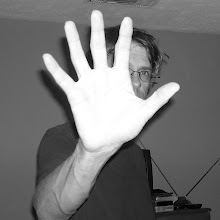Wrapped In Plastic #17 stands out to me as a particularly fine
issue for a number of reasons: First, it contained a wonderful essay by Rhonda Wilcox about vampirism in Twin Peaks. Second,
it included a lengthy letter from Tim Lucas of Video Watchdog fame. Third, it featured a long interview with Harley
Peyton about Twin Peaks and other Peyton projects.
This Harley Peyton interview “co-stars” Eric Stoltz and James Spader,
both of whom were present when we interviewed Peyton. (All three gentlemen were on location in Fort Worth making a film, and Craig Miller and I were lucky enough to visit the set.) Spader and Stoltz contributed a few crazy
interjections as we attempted to stay focused on our interview. Here’s one exchange:
Peyton: All the actors [on Twin Peaks] were great; we had no problems with them. The running of it was pretty simple.
Stoltz: Well, then, how come Kyle refused to cooperate?
Peyton: A very good question.
Thorne: We had heard that he didn't feel his character should be involved with someone who was supposedly under-age.
Peyton: Oh, Kyle! I don't know! You'd have to ask him. As I said, everyone was great. Michael Ontkean was tremendous. He's actually in the James Spader mold--he just wanted to stay at home. No, I shouldn't say that. I'm kidding! [laughter]
Spader: Just leave me out of it!
Stoltz: [To Spader] Don't talk to Harley!
Peyton: All these guys were great because they loved it. It really was a fun job. You'd go to this place every day and you'd do the work and everyone got along pretty well. So that part of it was wonderful.
 |
| Craig Miller (center) animatedly discusses Twin Peaks with Harley Peyton (right). (That's me on the left, chewing on a pen.) Photo likely by Eric Stoltz, 1995 |
I recommend tracking down WIP 17 for the full
interview. It’s something else.
But, wait, I’m getting sidetracked. . . .
What also excited me about WIP 17 was the cover.
Because we were printing our first in-depth interview with one of the
producers of Twin Peaks, we wanted to convey a “behind-the-scenes” concept for
the cover. We did not have any good photographs to use, so we decided to go with an illustration. Craig Miller had been
in touch with Chris Moeller, an accomplished artist who, at that time, was
working on the Shadows Empire comic book for Dark Horse Comics. Craig commissioned
Chris to do the cover for WIP 17 with a “behind-the-scenes” theme.
Chris produced a beautiful acrylic painting that depicts a possible scenario from the making of the Twin Peaks pilot: a make-up artist tends to Sheryl Lee as she waits, wrapped in plastic, for the shoot to begin.
I love the detail in the painting.
The make-up artist, with
her cosmetics and blow-dryer, kneels carefully in the shadow of the giant log where Laura has washed ashore;
the plastic that wraps Lee has a hint of translucence
revealing some skin tone underneath,
the smooth stones and driftwood are an embellishment, yet
these elements delicately balance the composition.
It’s a beautiful work of art!
For some reason, the painting took on a brown tone when the
cover was printed. I’m not sure why, as
the original was bluer and definitely had a “cooler” look to it.
For years, Craig had Chris Moeller’s original painting
prominently displayed in his office.
After Craig passed away, Howard Miller (Craig’s father) generously
offered the painting to me. I was thrilled and honored to get it; the original
cover to issue 17 is one of the great treasures from my years working on
Wrapped In Plastic.























